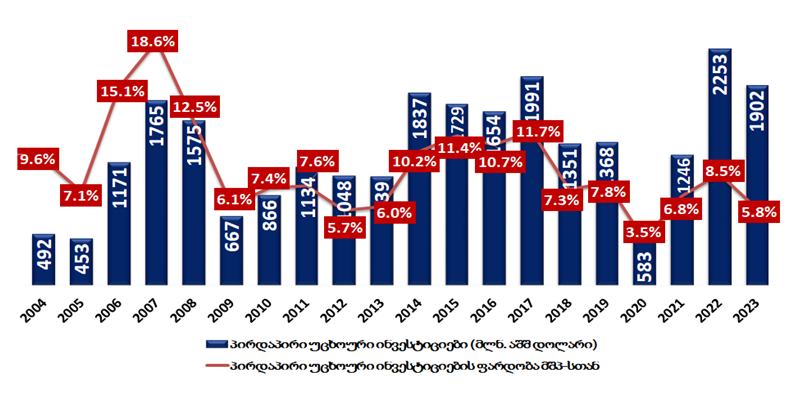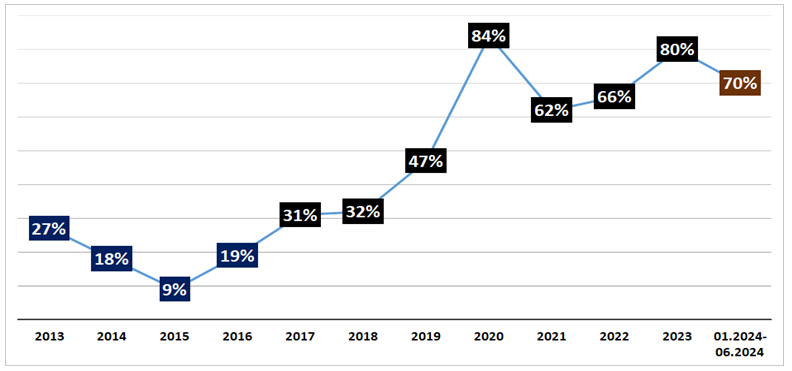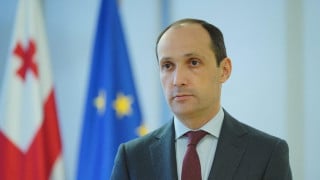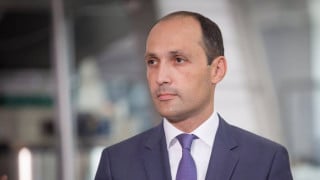Levan Davitashvili: “The increase in investment, including its ratio to the GDP, is unprecedented.”
Verdict: FactCheck concludes that Levan Davitashvili’s statement is FALSE.
Foreign direct investment exceeded USD 2.2 billion in 2022. Whilst this figure marks a record high in monetary terms, investment was higher in 2007, 2014 and 2017 when accounting for the purchasing power of the USD (the purchasing power of USD 1.8 billion in 2007 is equivalent to that of USD 2.5 billion in 2022).
The Minister placed a significant emphasis on the investment-to-GDP ratio but this statement is inaccurate. Percentages higher than that of 2022 were recorded eight times in the past, those higher than 2021 were recorded 13 times and those higher than 2022 were recorded 17 times.
Additionally, the monetary amounts of investment have also been on a downward trajectory since 2023. Investment experienced a 15% decrease in 2023 in monetary terms. Furthermore, the decline amounted to 34% in the first half of 2024 as compared to the same period the previous year.
Notably, the share of reinvestment in total investment has increased whilst that of new investments has declined.
The only partially accurate claim in the Minister of Economy and Sustainable Development’s statement is that investment has increased monetarily. However, the claim regarding the investment-to-GDP ratio is inaccurate. Furthermore, the overall negative trend and the decrease in the share of new investments in total investment were omitted. Considering the above, FactCheck concludes that Levan Davitashvili’s statement is FALSE.
Analysis
During his appearance on Rustavi 2’s show Ghamis Kurieri (News of the Night) Levan Davitashvili, the Minister of Economy and Sustainable Development, stated: “The increase in investment over the past few years, including its ratio to GDP, is unprecedented.”
Georgia received USD 5.4 billion in foreign direct investment following the pandemic, from 2021 to 2023. A historic monetary high of investments, over USD 2.2 billion, was recorded in 2022. However, investment decreased to USD 1.9 billion in 2023. Data from only six months of 2024 are available which indicate that investments in the January-July period of the current year are 34% lower as compared to the same period the previous year.
The Minister cited another important measure of investment, its ratio to the GDP, in his statement. However, there are no unprecedented achievements in this case in contrast to monetary data.
The investment-to-GDP ratio constituted 6.8% in 2021, 8.5% in 2022 and 5.8% in 2023. Whilst the data for investment in the third quarter of 2024 is not yet published and it is impossible to determine the level of investments in the fourth quarter, its ratio to the GDP will still decline due to economic growth, even if the investment figure remained at the 2023 level.
The highest level of the investment-to-GDP ratio following the pandemic was recorded in 2022 whilst the ratio varied between 10.2%-11.7% during the period from 2014 to 2017. Furthermore, this ratio even exceeded 15% in 2006 and 18% in 2007. The investment-to-GDP ratio exceeded the 8.5% mark eight times over the past 20 years – including four instances during the governance of the United National Movement and another four during the governance of the Georgian Dream. Taking 2023 as the base year for comparisons, the ratio was worse than the 2023 level in only two cases – in 2012 and 2020 – whilst it was higher in 17 instances. The FDI-to-GDP ratio averaged 9.3% from 2013 to 2019, dropping to 7% during 2021-2023, all under the governance of the Georgian Dream.
Graph 1: Foreign Direct Investment

Source: National Statistics Office of Georgia, World Bank
Investment in 2007, 2014 and 2017 exceeds the 2022 level in absolute terms when adjusting for the inflation of USD.
Additionally, it is also important to analyse the shares of new investment and reinvestment per one USD whilst discussing investments.
The rate of reinvestment reached 62% in 2021, 66% in 2022 and 80% in 2023. Furthermore, reinvestment constituted 70% of total investment in the first half of 2024. Reinvestment averaged 37% from 2017 to 2019 following the introduction of the Estonian model,[1] prior to the pandemic.
Graph 2: Rate of Reinvestment in Foreign Direct Investment

Source: National Statistics Office of Georgia
Both equity capital – new investment – and reinvestment are components of investment from an economic standpoint. Whilst the reinvestment of returns by existing investors is a positive sign, the lack of new investment points to certain issues.
The only partially accurate claim in the Minister of Economy and Sustainable Development’s statement is that investment has increased monetarily. However, the claim regarding the investment-to-GDP ratio is inaccurate. Furthermore, the overall negative trend and the decrease in the share of new investments in total investment were omitted. Considering the above, FactCheck concludes that Levan Davitashvili’s statement is FALSE.
[1] The so-called Estonian Model was adopted in 2017 under which a company is exempt from profit tax if it reinvests its profit.








